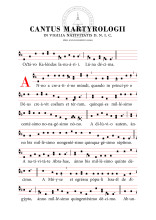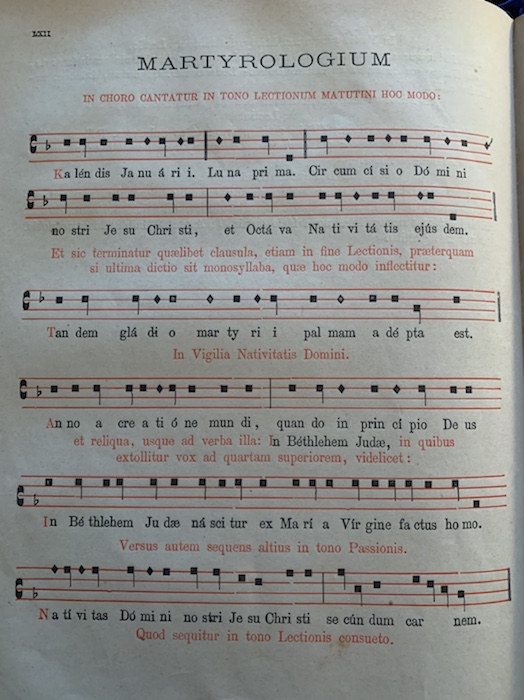QUAERITUR:
Would you happen to have a shareable PDF of the Proclamation for the Usus Antiquior in the modus ordinarius?
Before I answer that, let’s review.
We are talking here about the Kalendas, the solemn announcement of the birth of the Savior. It was sung at Prime. Since Prime isn’t being sung in many places, and since we need to have these good customs in far greater use, I say go ahead and sing it before Midnight Mass in the Usus Antiquior.
In the proclamation, the birth of Christ follows a list of important events, set points in history, which therefore puts the birth of Christ into the context of the history of salvation, beginning with the Creation of the world and culminating in the Nativity.
Remember that in the ancient world there was no standard calendar. So, one way to pinpoint events was to say what else was going on at the time according to other reckonings of time. The overlap of the dates would then give you the desired result, like a chronological Venn Diagram. The overlapping of the dates of the events cited in the Proclamation results in an accurate dating of the Nativity, that is 3/2 BC. There is good scholarship that reinforces 3/2 BC and cleans up a dating error for the year of Herod’s death.
I wrote about it at some length last year and made a recording for those who had to practice it. There is good PDF in Gregorian notation for the 2020 Kalendas (for the 2021 dates) at the site of Cappella Gregoriana Sanctæ Cæciliæ olim Xicatunensis.
PDF of the Modus Solemnior. HERE
The older Roman Martyrology has the notation for the Modus Ordinarius. It is rather like the “prophecy tone” and you raise the pitch at certain places.
Clearly, there is not much to that.
Try the modus solemnis.




































Thanks for the chant sheet, fr. Z.! That’ll come in handy…
The date of Our Lord’s birth is an interesting subject indeed. The dates in the Martyrology—which were calculated by Baronius, I believe—effectively converge on 2 BC, or 3 BC, or even 1 BC, depending on when you start the year (it wasn’t always Jan 1). A friend of mine, a nun (the good kind of nun) from Belgium (the good kind of Belgian, even rarer), Bieke Mahieu, wrote a very interesting book on the chronology of the Herodian dynasty, which supports December 25, 1 BC, as the date of the Lord’s birth. Here’s a link to it: HERE
I should emphasize that this is a work of serious scholarship, published by Peeters, a very reputable academic publisher; it isn’t a kooky attempt to disregard all evidence contrary to the traditional date. In fact, as far as I know it represents the state of the art on the difficult question of chronology for Roman-era Judaea. A lot of people who confidently assert that the Lord was born between 8 and 4 BC don’t realize that many generally accepted dates for Herodian reigns, Roman governorships, etc., rest entirely upon Flavius Josephus, who is known to be particularly unreliable. He’s off by more than 100 years for the date of construction of the Samaritan temple, for instance. He can’t even get the dates of the Emperors right.
[Interesting topic and source. Thanks.]
Being a European book were one wanting to track it down on Amazon I’d suggest using the Belgian or British Amazon. It pulls book listing from the local region often at a far lower price. In this case the US Amazon lists the book at well over $100. Amazon.au.uk listed it in the $70’s, still expensive but not as expensive. I imagine a Belgium search would discover a far cheaper version.
For what its worth.
A reason to support a 1 AD date for the Nativity is that the Lukan chronology gives a 15 month time span between the conception of St. John and the Nativity. John’s conception is celebrated on September 23 (east) or 24 (west) . The year 1 BC is the only reasonable year in which the Day of Atonement roughly corresponds to that date, which would also explain why Zacharias was in the Holy of Holies as tradition tells us, and scripture shows the people as rather worried about him taking so long (as if he may have made a mistake and died in there).
Anyway, 15 months later gives us December 25, 1 AD, which has always been the accepted date of the Nativity and I personally see no real reason to doubt it.